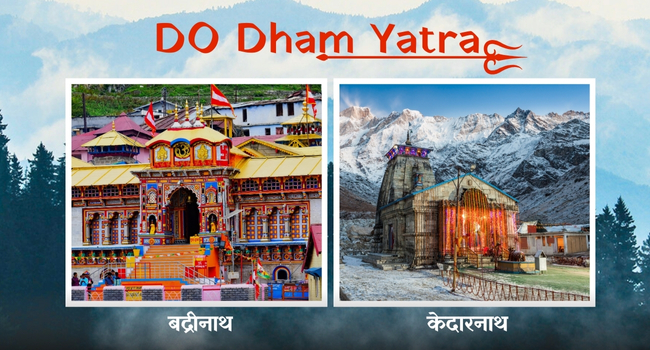Do Dham Yatra, covering the sacred sites of Kedarnath and Badrinath, is one of the holiest pilgrimages in India. Thousands of devotees undertake this journey to seek blessings and experience spiritual bliss every year. However, due to the high-altitude location of these temples, weather conditions play a crucial role in planning the trip. The best time to visit Do Dham depends on the accessibility, climate, and temple opening dates. The Do Dham best time to visit is primarily between May and October when the weather is favourable and the temples remain open. However, each season offers a unique experience:
Summer (May to June)
- The summer months are the most popular time for Do Dham Yatra.
- The weather is pleasant, with daytime temperatures ranging from 10°C to 20°C.
- Roads to Kedarnath and Badrinath are open, allowing easy temple access.
- Pilgrims can enjoy scenic views of the snow-capped Himalayas and lush green landscapes.
- Since this is the peak season, expect large crowds at both temples.
Monsoon (July to September)
- The monsoon season in Uttarakhand brings heavy rainfall and landslides.
- Rads to the temples can be blocked due to landslides, making travel unsafe.
- However, the surroundings look breathtaking, with lush greenery and waterfalls.
- The risk of flash floods increases, so travellers must check weather updates.
- Due to the dangers, it is advisable to avoid planning a trip during this time.
Post-Monsoon (September to October)
- The monsoon recedes by early September, allowing clear skies and refreshing weather.
- This is an excellent time for a pilgrimage with fewer crowds than summer.
- The views of the Himalayas are at their best, with fresh snow visible on the peaks.
- Pilgrims who prefer a peaceful journey should consider visiting during this period.
- As winter approaches in late October, temperatures start dropping, making it colder at night.
Winter (November to April)
- Winter in Do Dham is harsh, with temperatures dropping as low as -10°C or lower.
- Heavy snowfall blocks roads, making it impossible to access Kedarnath and Badrinath.
- Both temples remain closed during this time, and idol worship is shifted to lower-altitude locations.
- Only a few adventure seekers visit the region for winter trekking and snow exploration.
- Due to the extreme conditions, this is not a suitable time for pilgrims.
Ideal Season to Visit Do Dham for a Comfortable Journey
The ideal season to visit Do Dham depends on personal preferences and travel conditions. However, most pilgrims prefer summer and post-monsoon for a safe and comfortable trip.
- Best for Pilgrims – May to June and September to October are the most suitable months for temple visits.
- Best for Nature Lovers – September and October offer the most picturesque landscapes.
- Best for Trekking Enthusiasts – May to June is perfect for trekking to Kedarnath and exploring nearby lakes.
- Avoiding Crowds – Late September and early October provide a peaceful experience.
- Avoiding Harsh Weather – May and June offer the safest conditions for travel.
For a fulfilling pilgrimage, plan your trip during these months to experience a divine and comfortable journey.
When to Visit Do Dham for Special Occasions and Festivals
If you are wondering when to visit Do Dham to witness special events, consider these important dates:
Opening of Kedarnath and Badrinath Temples
- The temples open around April or May on Akshaya Tritiya, a highly auspicious Hindu festival.
- This marks the beginning of the pilgrimage season, drawing thousands of devotees.
Closing of Kedarnath and Badrinath Temples
- The temples close around October or November, on the day of Bhai Dooj.
- This is the final opportunity for pilgrims to seek blessings before the deities are moved to their winter locations.
Important Festivals
- Badri-Kedar Utsav (June) – A grand celebration at both temples with religious processions.
- Janmashtami (August-September) – Special prayers and rituals are held at Badrinath.
- Vijayadashami/Dussehra (October) – A major Hindu festival marking the triumph of good over evil.
Visiting during these festivals enhances the spiritual experience, allowing pilgrims to witness grand celebrations and rituals.
Tips for Visiting Do Dham in the Best Season
To make the most of your trip, consider these essential travel tips:
Plan According to the Weather: Check weather forecasts before your journey to avoid disruptions due to rain or snow. Carry appropriate clothing, especially warm layers, as temperatures can drop unexpectedly.
Book Accommodation in Advance: Hotels and guesthouses fill up quickly during the peak season, so booking is recommended. Pilgrims visiting in September or October can find better deals and less crowded stays.
Prepare for High Altitude Travel: Kedarnath and Badrinath are located at high elevations, so acclimatisation is necessary. Carry essential medicines and stay hydrated to avoid altitude sickness.
Choose the Right Mode of Transport: Helicopter services are available for those who wish to avoid long treks to Kedarnath. Road travel is best between May and October, but be cautious during the monsoon season.
Respect the Pilgrimage Traditions: Dress modestly and follow temple etiquette when visiting sacred sites. Maintain cleanliness and avoid littering in the temple premises and surrounding areas.
Choosing the best time to visit Do Dham ensures a safe, comfortable, and spiritually fulfilling experience. Summer (May to June) is the peak season with favourable weather, while post-monsoon (September to October) provides clear views and fewer crowds. Avoid travelling during monsoons due to landslides and during winter when temples are closed. Understanding the Do Dham best time to visit helps plan a successful pilgrimage without weather-related difficulties. Whether for religious purposes, trekking adventures, or witnessing special festivals, visiting during the ideal season to visit Do Dham enhances the journey. Plan your yatra wisely and experience the divine aura of Kedarnath and Badrinath at their best.




